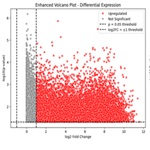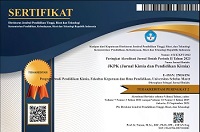
In Silico Pharmacokinetic and Microbiota-Integrated Profiling of Resveratrol Analogs
Abstract
Keywords
Full Text:
PDFReferences
[1] C. C. Koga, J. E. Andrade, M. G. Ferruzzi, and Y. Lee, "Stability of trans-resveratrol encapsulated in a protein matrix produced using spray drying to UV light stress and simulated gastrointestinal digestion," J. Food Sci., vol. 81, no. 2, pp. C292–C300, Feb. 2016, doi:10.1111/1750-3841.13176.
[2] A. Francioso, P. Mastromarino, R. Restignoli, A. Boffi, M. D’Erme, and L. Mosca, "Improved stability of trans-resveratrol in aqueous solutions by carboxymethylated (1,3/1,6)-β-D-glucan," J. Agric. Food Chem., vol. 62, no. 7, pp. 1520–1525, Feb. 2014, doi:10.1021/jf404155e.
[3] Z. Gan, Y. Zhang, X. Xu, Y. Zhang, Y. Wang, and Y. Wang, "Resveratrol and curcumin improve intestinal mucosal integrity and decrease m6A RNA methylation in the intestine of weaning piglets," ACS Omega, vol. 4, no. 17, pp. 17438–17446, Sep. 2019, doi:10.1021/acsomega.9b02236.
[4] D. Vergara, S. De Domenico, A. Tinelli, E. Stanca, L. L. Del Mercato, and A. M. Giudetti, "Anticancer effects of novel resveratrol analogues on human ovarian cancer cells," Mol. BioSyst., vol. 13, no. 6, pp. 1131–1141, Jun. 2017, doi:10.1039/C7MB00128B.
[5] Z. Liu, H. Li, J. Liu, M. Wu, X. Chen, and L. Liu, "Inactivated Wnt signaling in resveratrol-treated epidermal squamous cancer cells and its biological implication," Oncol. Lett., vol. 14, no. 2, pp. 2239–2243, Aug. 2017, doi:10.3892/ol.2017.6458.
[6] C. Hsueh, V. Hsu, P. Zhao, L. Zhang, K. M. Giacomini, and H. S. M. Leung, "PBPK modeling of the effect of reduced kidney function on the pharmacokinetics of drugs excreted renally by organic anion transporters," Clin. Pharmacol. Ther., vol. 103, no. 3, pp. 485, 2018.
[7] S. Willmann, H. Höhn, R. Edginton, M. Sevestre, A. Solodenko, and T. Lippert, "Applications of physiologically based pharmacokinetic modeling of rivaroxaban—Renal and hepatic impairment and drug‐drug interaction potential," J. Clin. Pharmacol., vol. 61, no. 5, pp. 656–665, May 2021, doi:10.1002/jcph.1784.
[8] H. S. Shah, K. Shah, B. Gajera, R. H. Dave, and D. R. Taft, "Developing a formulation strategy coupled with PBPK modeling and simulation for the weakly basic drug albendazole," Pharmaceutics, vol. 15, no. 4, p. 1040, Apr. 2023, doi:10.3390/pharmaceutics15041040.
[9] V. Kushwah, S. Arora, M. T. Katona, D. Modhave, E. Fröhlich, and A. Paudel, "On absorption modeling and food effect prediction of rivaroxaban, a BCS II drug orally administered as an immediate-release tablet," Pharmaceutics, vol. 13, no. 2, p. 283, Feb. 2021, doi:10.3390/pharmaceutics13020283.
[10] Z. Xiao, Q. Ye, X. Duan, and T. Xiang, "Network pharmacology reveals that resveratrol can alleviate COVID-19-related hyperinflammation," Dis. Markers, vol. 2021, pp. 1–12, 2021, doi:10.1155/2021/4129993.
[11] L. Guo, Y. Zhang, H. Liu, X. Wang, and J. Li, "Therapeutic role and potential mechanism of resveratrol in atherosclerosis: TLR4/NF-κB/HIF-1α," Mediators Inflamm., vol. 2023, pp. 1–13, 2023, doi:10.1155/2023/1097706.
[12] Y. Zheng, Z. Zhong, and X. Guo, "Network pharmacology-based and molecular docking analysis of resveratrol’s pharmacological effects on type I endometrial cancer," Anticancer Agents Med. Chem., vol. 22, no. 10, pp. 1933–1944, Oct. 2022, doi:10.2174/1871520621666211015140455.
[13] N. Gligorijević, M. Radomirović, A. Rajković, O. Nedić, and T. Ć. Veličković, "Fibrinogen increases resveratrol solubility and prevents it from oxidation," Foods, vol. 9, no. 6, p. 780, Jun. 2020, doi:10.3390/foods9060780.
[14] R. Zamora‐Ros, M. A. Rothwell, C. A. Knox, L. M. Guino, and M. J. Touillaud, "Evaluation of urinary resveratrol as a biomarker of dietary resveratrol intake in the European prospective investigation into cancer and nutrition (EPIC) study," Br. J. Nutr., vol. 117, no. 11, pp. 1596–1602, Jun. 2017, doi:10.1017/S0007114517001465.
[15] M. A. Malinowska, J. Kowalski, and L. Nowak, "Trans-resveratrol as a health beneficial molecule: Activity, sources, and methods of analysis," Sci. Rad., vol. 2, no. 3, pp. 268–294, Sep. 2023, doi:10.58332/scirad2023v2i3a04.
[16] L. Liang, Z. Liu, X. Yang, Y. Zhang, H. Liu, and Y. Chen, "Prediction of blood‐brain barrier permeability using machine learning approaches based on various molecular representation," Mol. Inform., vol. 43, no. 9, Sep. 2024, doi:10.1002/minf.202300327.
[17] J. Zhang, Y. Wang, Z. Liu, X. Chen, and H. Xu, "Combining mechanistic and machine learning models for predictive engineering and optimization of tryptophan metabolism," Nat. Commun., vol. 11, no. 1, p. 488, Jan. 2020, doi:10.1038/s41467-020-17910-1.
[18] M. Čuperlović‐Culf, "Machine learning methods for analysis of metabolic data and metabolic pathway modeling," Metabolites, vol. 8, no. 1, p. 4, Jan. 2018, doi:10.3390/metabo8010004.
[19] A. R. Neves, S. Reis, and M. A. Segundo, "Development and validation of a HPLC method using a monolithic column for quantification of trans-resveratrol in lipid nanoparticles for intestinal permeability studies," J. Agric. Food Chem., vol. 63, no. 12, pp. 3114–3120, Mar. 2015, doi:10.1021/acs.jafc.5b00390.
[20] P. Bannigan, M. Aldeghi, Z. Bao, F. Häse, A. Aspuru‐Guzik, and C. Allen, "Machine learning directed drug formulation development," Adv. Drug Deliv. Rev., vol. 175, p. 113806, Jul. 2021, doi:10.1016/j.addr.2021.05.016.
[21] A. D. Becke, "Density-functional thermochemistry. III. The role of exact exchange," J. Chem. Phys., vol. 98, no. 7, pp. 5648–5652, Apr. 1993, doi:10.1063/1.464913.
[22] R. Krishnan, J. S. Binkley, R. Seeger, and J. A. Pople, "Self-consistent molecular orbital methods. XX. A basis set for correlated wave functions," J. Chem. Phys., vol. 72, no. 1, pp. 650–654, Jan. 1980, doi:10.1063/1.438955.
[23] P. Kotora, F. Šeršeň, J. Filo, D. Loos, J. Gregáň, and F. Gregáň, "The scavenging of DPPH, galvinoxyl and ABTS radicals by imine analogs of resveratrol," Molecules, vol. 21, no. 1, p. 127, Jan. 2016, doi:10.3390/molecules21010127.
[24] P. L. Toh, R. Rasmidi, M. Meepripruk, L. S. Ang, S. Sulaiman, and M. I. Mohamed–Ibrahim, "First principles density functional theory investigation on the structural, energetic and electronic properties of 6–bromo–4–oxo–4H–chromene–3–carbaldehyde," Appl. Mech. Mater., vol. 835, pp. 308–314, 2016, doi:10.4028/www.scientific.net/amm.835.308.
[25] A. Bendi, S. Atri, G. B. D. Rao, M. J. Raza, and N. Sharma, "Ultrasound-accelerated, concise, and highly efficient synthesis of 2-oxazoline derivatives using heterogeneous calcium ferrite nanoparticles and their DFT studies," J. Chem., vol. 2021, pp. 1–12, 2021, doi:10.1155/2021/7375058.
[26] M. D. Hanwell, D. Curtis, D. Lonie, T. Vandermeersch, E. Zurek, and G. Hutchison, "Avogadro: an advanced semantic chemical editor, visualization, and analysis platform," J. Cheminform., vol. 4, no. 1, p. 17, 2012, doi:10.1186/1758-2946-4-17.
[27] D. E. V. Pires, T. L. Blundell, and D. B. Ascher, "pkCSM: predicting small-molecule pharmacokinetic and toxicity properties using graph-based signatures," J. Med. Chem., vol. 58, no. 9, pp. 4066–4072, May 2015, doi:10.1021/acs.jmedchem.5b00104.
[28] F. W. Hu, L. L. Tsai, C. H. Yu, P. N. Chen, M. Y. Chou, and C. C. Yu, "Impairment of tumor-initiating stem-like property and reversal of epithelial–mesenchymal transdifferentiation in head and neck cancer by resveratrol treatment," Mol. Nutr. Food Res., vol. 56, no. 8, pp. 1247–1258, Aug. 2012, doi:10.1002/mnfr.201200150.
[29] R. Dennington, T. Keith, and J. Millam, GaussView, Version 6.0, Semichem Inc., Shawnee Mission, KS, USA, 2016.
[30] Y. Liu and R. L. Sprando, "Physiologically based pharmacokinetic modeling and simulation of cannabinoids in human plasma and tissues," J. Appl. Toxicol., vol. 43, no. 4, pp. 589–598, Apr. 2022, doi:10.1002/jat.4409.
[31] J. Chung et al., "Utilizing physiologically based pharmacokinetic modeling to inform formulation and clinical development for a compound with pH-dependent solubility," J. Pharm. Sci., vol. 104, no. 4, pp. 1522–1532, Apr. 2015, doi:10.1002/jps.24339.
[32] M. I. Love, W. Huber, and S. Anders, "Moderated estimation of fold change and dispersion for RNA-seq data with DESeq2," Genome Biol., vol. 15, no. 12, Dec. 2014, doi:10.1186/s13059-014-0550-8.
[33] P. Gao and G. Ren, "Identification of potential target genes of non-small cell lung cancer in response to resveratrol treatment by bioinformatics analysis," Aging (Albany NY), vol. 13, no. 19, pp. 23245–23261, Oct. 2021, doi:10.18632/aging.203616.
[34] L. Sun et al., "Gut microbiota and intestinal FXR mediate the clinical benefits of metformin," Nat. Med., vol. 24, no. 12, pp. 1919–1929, Dec. 2018, doi:10.1038/s41591-018-0222-4.
[35] D. F. Veber, S. R. Johnson, H. Y. Cheng, B. R. Smith, K. W. Ward, and K. D. Kopple, "Molecular properties that influence the oral bioavailability of drug candidates," J. Med. Chem., vol. 45, no. 12, pp. 2615–2623, Jun. 2002, doi:10.1021/jm020017n.
[36] C. A. Lipinski, B. W. Dominy, and P. J. Feeney, "Experimental and computational approaches to estimate solubility and permeability in drug discovery and development settings," Adv. Drug Deliv. Rev., vol. 23, no. 1–3, pp. 3–25, Mar. 1997, doi:10.1016/S0169-409X(96)00423-1.
[37] F. P. Guengerich, "Cytochrome P450 and chemical toxicology," Chem. Res. Toxicol., vol. 21, no. 1, pp. 70–83, Jan. 2008, doi:10.1021/tx700079z.
[38] R. H. Houtkooper, E. Pirinen, and J. Auwerx, "Sirtuins as regulators of metabolism and healthspan," Nat. Rev. Mol. Cell Biol., vol. 13, no. 4, pp. 225–238, Apr. 2012, doi:10.1038/nrm3293.
[39] M. Lagouge et al., "Resveratrol improves mitochondrial function and protects against metabolic disease by activating SIRT1 and PGC-1α," Cell, vol. 127, no. 6, pp. 1109–1122, Dec. 2006, doi:10.1016/j.cell.2006.11.013.
[40] B. D. Gehm, J. M. McAndrews, P.-Y. Chien, and J. L. Jameson, "Resveratrol, a polyphenolic compound found in grapes and wine, is an agonist for the estrogen receptor," Proc. Natl. Acad. Sci. USA, vol. 94, no. 25, pp. 14138–14143, Dec. 1997, doi:10.1073/pnas.94.25.14138.
[41] J. Subbaramaiah, D. A. Jang, T. T. Pezzuto, T. N. Tan, M. P. Goldberg, and C. W. Jang, "Resveratrol inhibits cyclooxygenase-2 transcription and activity in phorbol ester-treated human mammary epithelial cells," J. Biol. Chem., vol. 273, no. 34, pp. 21875–21882, Aug. 1998, doi:10.1074/jbc.273.34.21875.
[42] A. Csiszar et al., "Resveratrol induces mitochondrial biogenesis in endothelial cells," Am. J. Physiol. Heart Circ. Physiol., vol. 297, no. 1, pp. H13–H20, Jul. 2009, doi:10.1152/ajpheart.00368.2009.
[43] A. L. Hopkins, "Network pharmacology: The next paradigm in drug discovery," Nat. Chem. Biol., vol. 4, no. 11, pp. 682–690, Nov. 2008, doi:10.1038/nchembio.118.
[44] T. Liu et al., "Verification of resveratrol inhibits intestinal aging by downregulating ATF4/Chop/Bcl-2/Bax signaling pathway: Based on network pharmacology and animal experiment," Front. Pharmacol., vol. 11, p. 1064, 2020, doi:10.3389/fphar.2020.01064.
[45] K. Wang et al., "Physiologically based pharmacokinetic models are effective support for pediatric drug development," AAPS PharmSciTech, vol. 22, no. 6, p. 208, Jun. 2021, doi:10.1208/s12249-021-02076-w.
[46] I. M. Kapetanović et al., "Pharmacokinetics, oral bioavailability, and metabolic profile of resveratrol and its dimethylether analog, pterostilbene, in rats," Cancer Chemother. Pharmacol., vol. 68, no. 3, pp. 593–601, Sep. 2011, doi:10.1007/s00280-010-1525-4.
[47] S. Timmers et al., "Calorie restriction-like effects of 30 days of resveratrol supplementation on energy metabolism and metabolic profile in obese humans," Cell Metab., vol. 14, no. 5, pp. 612–622, Nov. 2011, doi:10.1016/j.cmet.2011.10.002.
[48] T.-C. Hsieh et al., "Functional/activity network (FAN) analysis of gene-phenotype connectivity liaised by grape polyphenol resveratrol," Oncotarget, vol. 7, no. 25, pp. 38670–38680, Jun. 2016, doi:10.18632/oncotarget.9578.
[49] H. Dai et al., "Resveratrol inhibits the malignant progression of hepatocellular carcinoma via MARCH1-induced regulation of PTEN/AKT signaling," Aging (Albany NY), vol. 12, no. 12, pp. 11717–11731, Jun. 2020, doi:10.18632/aging.103338.
[50] T. Cai et al., "Resveratrol modulates the gut microbiota and inflammation to protect against diabetic nephropathy in mice," Front. Pharmacol., vol. 11, p. 1249, 2020, doi:10.3389/fphar.2020.01249.
[51] I. Milton‐Laskibar, A. Cuevas‐Sierra, M. P. Portillo, and J. A. Martínez, "Effects of resveratrol administration in liver injury prevention as induced by an obesogenic diet: Role of Ruminococcaceae," Biomedicines, vol. 10, no. 8, p. 1797, Aug. 2022, doi:10.3390/biomedicines10081797.
Refbacks
- There are currently no refbacks.








